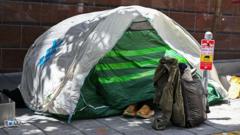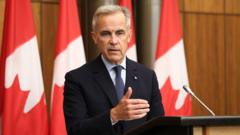The adoption of stringent measures against homelessness in Washington D.C. reflects San Francisco's past approaches. While some claim effectiveness in reducing visible encampments, advocates warn of potential harm and question the long-term solutions to an ongoing crisis.
Washington D.C. Mirrors San Francisco in Addressing Homelessness with Controversial Tactics

Washington D.C. Mirrors San Francisco in Addressing Homelessness with Controversial Tactics
As the U.S. capital implements aggressive policies to clear homeless encampments, it draws parallels to San Francisco's recent strategies in tackling homelessness.
In a striking parallel to San Francisco's struggles with homelessness, Washington D.C. has recently initiated an aggressive campaign to clear encampments, echoing San Francisco's prior tactics that have garnered considerable attention. Over the years, San Francisco has become notorious for its visible homelessness, prompting a crackdown that has significantly changed the city's landscape.
Last week marked the onset of similar measures in D.C., with federal agents actively dismantling homeless encampments—a controversial response to a deeper societal issue. Sparked by a Supreme Court ruling that allowed municipalities to penalize individuals for camping without shelter, this trend has begun to sweep across numerous cities in the U.S., uniting mayors like Donald Trump and Gavin Newsom in their opposition to visible homelessness.
The pandemic exacerbated the homelessness crisis, especially in high-cost cities like San Francisco, where soaring property prices and factors such as mental health and addiction have further complicated the situation. The number of tents observed in San Francisco saw dramatic growth during the pandemic, emphasizing the urgent need for viable solutions.
In response, local initiatives for housing have accelerated. Vivian Wan from Abode emphasized the quick responses to moving people into shelters, although the backlash bemoaned the location of supportive housing projects in certain neighborhoods. The situation became a source of political contention, especially for then-Mayor London Breed, who adopted an aggressive enforcement strategy in 2024, prompting a significant uptick in citations for illegal lodging.
Despite the city's efforts, advocates argue that punitive measures merely cycle vulnerable populations without addressing underlying issues. “It's not a true solution,” said Chione Flegal, highlighting that criminalizing homelessness shows a misunderstanding of systemic issues at play.
Recent statistics illustrate the complexities of the crisis. While San Francisco reported a decline in tent counts, the overall number of individuals experiencing homelessness rose to troubling new heights. Advocates fear that measures like D.C.’s might only shift the problem elsewhere, emphasizing the need for comprehensive, sustainable solutions rather than just visible clean-up efforts.
Mayor Lurie of San Francisco has pledged significant resources—$846 million to confront these growing issues—with plans for new shelter and treatment facilities. His approach insists that addressing this crisis requires a multifaceted strategy involving not just shelter but actual treatment and recovery programs.
Reactions to Lurie’s plans indicate a cautious optimism amongst residents. Yet, experts warn that aggressive removal tactics create instability for the homeless, asserting that a compassionate, gradual approach is crucial to effectively manage and alleviate homelessness without merely pushing it out of sight.
As Washington D.C. adopts these practices, the narrative begs for deeper examination of genuine, long-lasting solutions crucial to tackling the core issues of homelessness—an endeavor that transcends political theatrics and demands collective compassion and innovation.



















